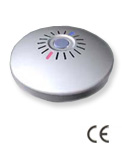
PDF:  size: 133KB size: 133KB
|
SPECIFICATION:
Main Power Source: 230-240V a.c.50Hz
Secondary Power Source: 9V d.c.Carbon Zinc or Alkaline battery
Operating Current: 35mA
Battery Life: 1 year ap0proximately
Operating Temperature: 5C-45C
Ambient Humidity: 10%-90%
Inter-connecting: 20Gabel series alarms over 150 metres max.
Horn Level: 85dB at 3 meters min.
Visual Indicators: Green LED for mains power on red LED for warming and low battery indication
Approvals:CE
Certificate of Suitability: CE
|
Approvals
The DSW2288 smoke alarm has been tested to EN 61000-6-3:2001 and EN50130-4:1995+A,by Electrical-Safety Technology Co.Ltd. |
FAQS
Interconnecting DSW Series smoke alarms
Interconnecting alarms increases householder safety.Ther are a number of important issues regarding interconnection to note:
1. Only use DSW series alarms together.Other brands may operate on a different interconnect voltage and not interact property.
2. The DSW series of smoke alarms put a 8V-9VDC alarm interconnect signal over the I and N wires.All interconnected alarms need to be on a single circuit and must share a common neutral.
3. Up to 40 alarm over 150 metres may be interconnected.
4. Read all instructions supplied with every DSW series smoke alarm,before installation.
|
| DSW2288 applications and usages |
Technology : Uses no radioactive material,Instead,uses a light emitter and receiver to delect smoke.If no smoke particles are present,no light reaches the receiver.When smoke particles are present some light is refiected or fefracted onto the receiver,triggering the alarm.
Advantages: Are sensitive to large smoke particles associated with smouldering fires.Will provide earlier warming than an ionization alarm in these conditions.
Disadvantages: Slower to respond to fast flaming fires.More prone to dust or insect contamination than ionization alarms.
Where to use: Smoker's bedrooms,Small confined apartments,Near kitchens,Family rooms
Where not to use: Bathrooms,Dust or insect prone areas |
| |
|
|
